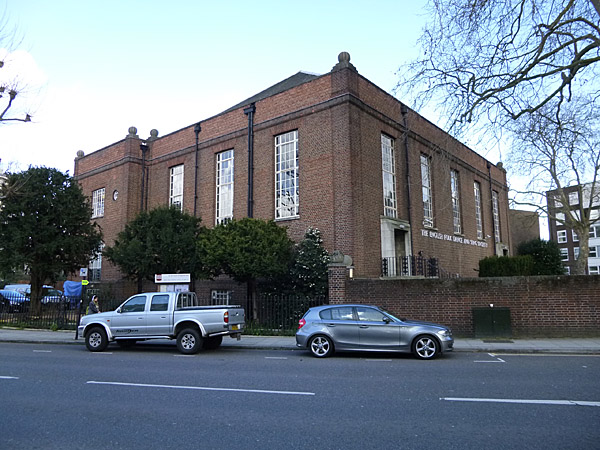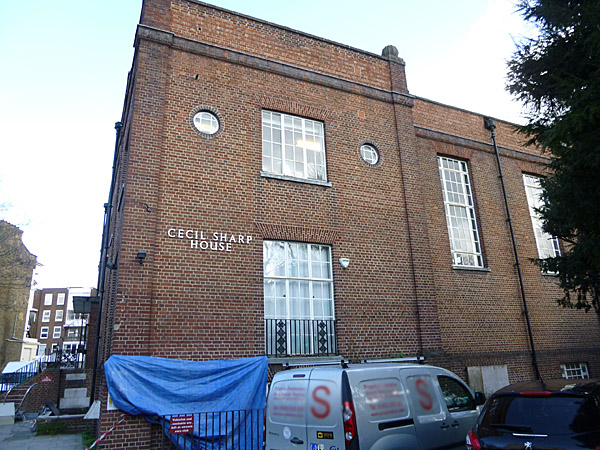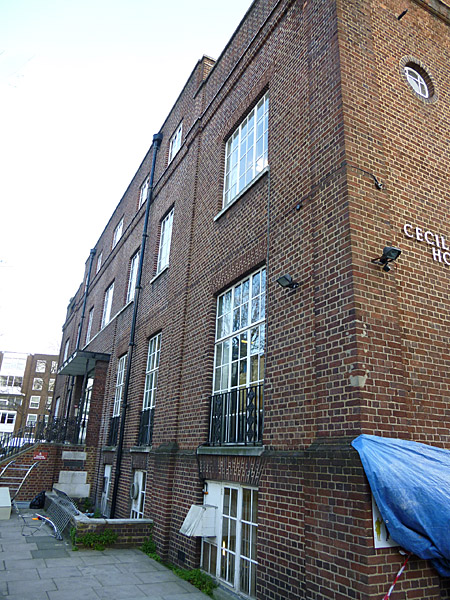This Grade II listed
building occupies a triangular shaped site
at the junction of Regent's Park Road and
Gloucester Avenue, in Camden. It was
built originally in 1929 and dedicated to
Cecil Sharp in honour of his work in
restoring the heritage of country songs and
dance. At the time of his death Sharp
had been the Director of the English Folk
Dance Society. The building is faced
in Staffordshire brick with stone dressings
around the doors.

The London Open House
website carried a description of the inside
of the building. It said that, "The
building was thought to be very modern
in construction. Contemporary
architectural journals saw this as an
indication of the forward thinking of
the Folk Society. The ground floor
was raised to enable natural light to
shine into the basement, which housed
the two smaller classrooms, changing
rooms and buffet. The window glass was
called ‘Vita’ glass, which was reported
to have health giving properties as it
let in ultra-violet rays.
... The main dance space, Kennedy Hall,
has a sprung floor and the original wood
was Kauripine. Initially, there was a
‘minstrel’s gallery’ with carvings by
William Simmonds of the Art Workers’
Guild. The ceiling and walls had one of
the earliest acoustic treatments by Hope
Bagenal who was a friend of Fletcher,
the architect. Hope Bagenal was one of
the first architects to be interested in
the problem of acoustics."
Beside the entrance steps are three
commemorative stone blocks.



During the bombing of
World War II the building suffered extensive
damage including the destruction of the
gallery in Kennedy Hall. In 1948 J.
Eastwick-Field was appointed as the
architect to lead the restoration of the
building. The London Open House
website explains that, "The
new architects preserved much of the
character of the original design, but
added a storey and modified the interior
in an effort to capture the present
spirit of architectural aesthetics and
of the Society. In the absence of the
gallery, the artist Ivon Hitchen was
commissioned to create a mural on the
blank wall, reflecting the forms and
fluid movements of folk dance."
The block below reads "The building
was partly destroyed by enemy action in
September 1940 and after being rebuilt
and extended was reopened by HRH
Princess Margaret on the 5th of June
1951."

The English Folk Dance
and Song Society describe Cecil Sharp House
as, "A world-class
dedicated folk arts centre ... (that)
... exists to serve its wide and diverse
audiences - engaging with art lovers
(oft times folk art lovers) through
unique and inspiring artistic events,
and creative learning. ... One
of the most legendary and historic
venues in London, Cecil Sharp House has
served as a location for films,
television programmes and fashion
shoots. The roster is packed with barn
dances, ceilidhs, traditional folk
luminaries and the occasional ukulele
shenanigan. The House has also played
host to some of the biggest names in
folk and popular music including Martin
& Eliza Carthy, Davy Graham, Mumford
& Sons, Bellowhead, Laura Marling,
Graham Coxon, and Goldfrapp."





